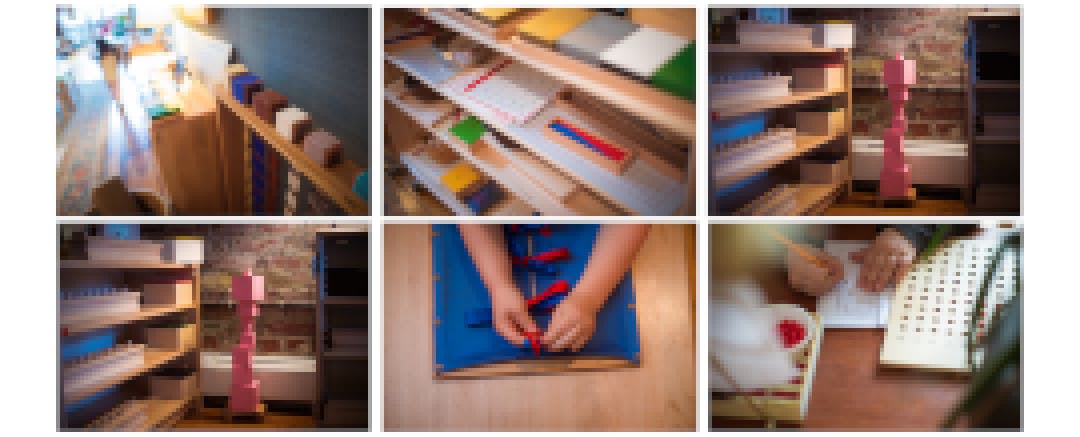CAMBRIDGE, Mass. — On a tree-lined avenue, between shops, cafes and row houses about a half mile from Harvard University, sits a uniquely high-tech school in a narrow storefront. Kids don’t spend time in front of screens, though. In fact, they never even see them. Instead, the tech is embedded into the environment almost invisibly. Cameras record students, who range in age from two to six, as they move around the room, and sensors in their matching green slippers track their exact location and the objects they touch.
This is the flagship location of Wildflower, a 21-school Montessori network that spans multiple states, including a handful in Puerto Rico. But as compelling as the technology is, it might not be the strangest thing about Wildflower. A close contender might be its flexible operations model, which fully embraces what education reform advocates call “school choice,” and blurs the lines between public, private and charter schools.
Founded in 2014, Wildflower was borne out of an idea from Sep Kamvar, a professor at MIT’s Media Lab, who was looking for a school for his son as a new resident of Cambridge. Not finding anything he liked, he enlisted a handful of veteran Montessorians who, together, created the outline for the micro-school, which has locations serving kids as young as three-months old through to grade 12. Along the way they picked up a clutch of supporters, including the Chan Zuckerberg Initiative (CZI), the Walton Family Foundation and various venture capital firms, which have given more than $10 million in grants. (CZI also provides grant support to EdSurge.)
Wildflower began its life as a private school network, charging students tuition north of $15,000 a year, explains Matt Kramer, Wildflower’s CEO. However, Kamvar (who still sits on the board) provided scholarships to some students in an effort to better reflect the diversity of the Boston-area community where he lived.
“As the number of schools grew, that became no longer a workable plan,” Kramer says. He began a quest to learn how to fit the model into different governance laws, with public funding.
Like the Montessori model itself, the Wildflower network was never designed to fit into traditional notions of what a school system should look like. The network is decentralized, meaning schools share some resources but otherwise operate independently of one another. It’s neither public, private nor charter, but is open to operating in all three spheres.
In Puerto Rico, its schools are administered by the territory’s department of education, and teachers are on local district payrolls. Minnesota operates the only full charter school in the group, although Wildflower was recently approved for a charter in New York. The network’s other schools operate independently, supported through tuition. Some students use vouchers, to reduce costs to either 50 or 90 percent of standard tuition based on need. “It depends on what exists in the local area,” Kramer says. “We even have [a school] in Indiana that uses vouchers through age 12.”
As for staffing, Wildflower keeps things lean. It’s set up so that two teachers, or teacher-leaders as they’re called, can run a classroom or even a small school site without any additional administrative oversight. Teachers-leaders come from a variety of backgrounds, but must be Montessori trained and meet state teaching requirements.
Schools can run without the overhead of an office staff, which creates flexibility but can also result in headaches when the model rubs against charter-school accountability requirements that were written for schools with a much larger staff that can keep up with reams of paperwork.
Kramer says Montessori schools also struggle with showing states that students master standards, since kids focus largely on independent pursuits during the day. Wildflower students do not take traditional classroom assessments. Instead, their growth is measured in ways that reflect Montessori values like observations and portfolios. As a result, the network has designed special assessments that satisfy both states and Montessori purists (and still, public and charter schools are not exempt from standardized assessments.)
These complexities create some hurdles when it comes to navigating accountability in charter and district environments. Another challenge with the model is also one of its selling points: its intentionally small class sizes.
Each school serves about 25-50 kids with about 8 to 10 at each age level. “That is well below the necessary sample size for a test score based accountability,” Kramer says. “Trying to shoehorn in micro-schools for accountability requirements that were designed for bigger schools is tricky. It requires forward thinking [state-level] authorizers working with us to figure it out.”
A Modern Take on Montessori
Wildflower classrooms look like traditional Montessori classrooms. The environment is designed around the child. Wall art is sparse and hung low to line up with a child’s line of vision. Furniture and objects are intentionally small to promote independence. Materials are made from wood or metal, not plastic, and technology is virtually nonexistent.

Teacher-leaders heavily curate the environment that children interact with. “There’s a basement full of materials that rotate to stay interesting for kids,” says Mary Rockett, a teacher-leader at Wildflower’s flagship school.
Wild Rose, another Cambridge location and one of the larger schools in the system, is broken into two distinct classrooms: one for preschoolers up to age six and another for students as old as 11. Large windows let both classes observe each other—something teachers say is aspirational for younger kids, who are encouraged to look up to older kids who may help them learn.
Operating in storefronts, school footprints are too small to include outdoor spaces, which are encouraged in Montessori schools, so classes use local parks instead. This intentional approach is designed to reflect what kids might do with their time away from school anyway, like playing outside or going apple picking. “It feels more like some cross between homeschooling and regular institutional schooling,” Kramer says. “It feels like you don't have to step so far from reality to our school.”
The schools hew closely to traditional Montessori method. Students spend large portions of their day choosing how to occupy their time, while teachers observe and sometimes suggest—or “guide” in Montessori parlance—students to try something new. Teachers often take turns interacting with students and stepping back to observe children and log their progress.
Students do receive short lessons in science, geography, language arts, music and other core subjects. Sometimes it’s by request, but always when teachers and students feel they’re ready. Otherwise, days are largely untethered from traditional structure. In general students learn through interacting with objects placed strategically around the classroom, designed to slowly build skills and scale in complexity.
Kids are also largely well behaved. They’re given model language by teachers and regular lessons in what’s known as grace and courtesy—learning how to politely decline help and resolve issues with classmates on their own. “The environment has been specifically designed to meet their needs so they don't need to ask for something,” Rockett says. “That eliminates a lot of conflict.”
A certain level of independence is expected from kids—even young toddlers are taught to put on and remove the sensor-carrying slippers each day. A young child might sit for long, uninterrupted periods of time pouring beads from a pitcher into a small saucer and back again, interacting with others only when she wants. After a certain period of time—hours or days—a teacher-leader might guide her to a more challenging activity around counting. “It’s about preparation of the environment,” Rockett says. “Making sure there are enough choices but not too many.”

There is no such thing as too much observation for teachers, who keep track of engagement, concentration and interactions using paper charts. They also keep track of whether students are moving through curricular sequences, like counting, addition and multiplication, and how quickly.
Such record keeping comes directly from methods pioneered by Maria Montessori, the early 20th century Italian educator whose work forms the basis for the model.
“Maria Montessori did all this tracking of concentration levels in the classrooms,” says Rockett. “She recognized patterns and we try and recreate those.” Children are tracked on how long they interact with an object, whether they have something out but aren’t using it or whether they’re actively engaged and concentrating. The goal is to find the periods of time when children are at their most creative or receptive to instruction. Often it’s after returning from the playground or a long activity where they have had to switch environments. But Rockett acknowledges every child is different.
It’s in this meticulous logging and data tracking that teacher-leaders see the most promise for technology. “The real challenge has not been collecting data but having time to analyze, synthesize and interpret data,” Rockett explains. “If tech can do that for me, that's really exciting.”
Cameras and Sensors and Slippers—Oh My!
From the start, finding ways to improve observation and record-keeping using tech was a key goal. Transparent Classroom, a cloud-based record-keeping system designed for Montessori classrooms, serves as a digital progress log, though teachers still have to key in data manually.
But at Wildflower, the tech goes beyond digitizing observation logs. The organization has a team of in-house engineers developing cameras and sensors tucked into classroom materials and slippers.
All Wildflower schools operate as “lab schools,” where new approaches and experimentation are encouraged. “We take a fact-based approach to improving our way of doing things,” Kramer says. While the goal is for this tech to evolve into something that works for all Wildflower schools, it’s starting small. The cameras and sensors are developed and tested by an engineering team in a lab before being brought to pilot classrooms.
For now, technology isn’t very useful for anyone—the collected data is still too raw and unwieldy to be of much help.
In theory, the sensors track where students are and which objects they’re near, while cameras can help distinguish interactions from proximity. Where sensors might be able to tell a teacher that two children spent an hour next to each other near an abacus-like counting chain, the cameras can identify how they were interacting with it.
“The data, as you can just imagine, is just enormous,” says Kramer, adding that they’re working on AI that can sift through it to make it resemble something a teacher would collect.
“We are not yet at the point where I can use a lot of the data they are gathering,” Rockett says. But she speculates that one day it could lead to better observations about students, such as letting her know objectively if she’s spending too much time with any one child. That will ultimately require useable data from both sensors and cameras.
Engineers and teachers are also working though a number of challenges related to privacy. Wildflower doesn’t want kids’ faces captured, and tries to de-identify data whenever possible. Yet it hasn’t yet decided whether to process images on site or at other off-campus locations. Kramer says Wildflower follows a set of standard protections around data privacy, and so far parents have been understanding—largely because parents are briefed about the data collection when they first tour the school.
Kramer contends that the data being collected is relatively low-risk and gathered only in areas where teachers are already collecting similar information. And because the data is so archane, its use outside the Montessori context—for the general public or even parents—is limited.
For Rockett, the appeal of the technology is that it augments the work she’s already doing, and is entirely invisible to kids. “I consider myself one of the most Montessori purists I know and I feel very strongly the day it interrupts the children and its development, that's the day we stop implementing it in our classroom,” she says. “But if it can support teachers in supporting children without ever influencing the classroom, I’m all for it.”


